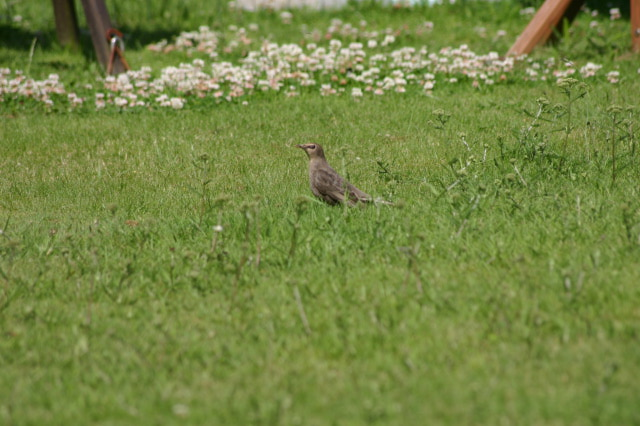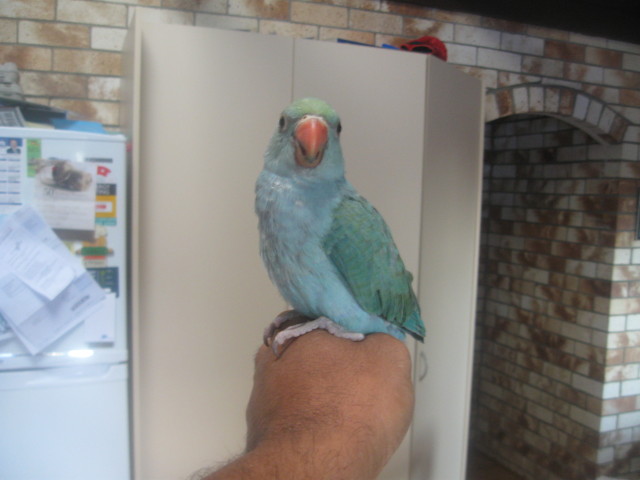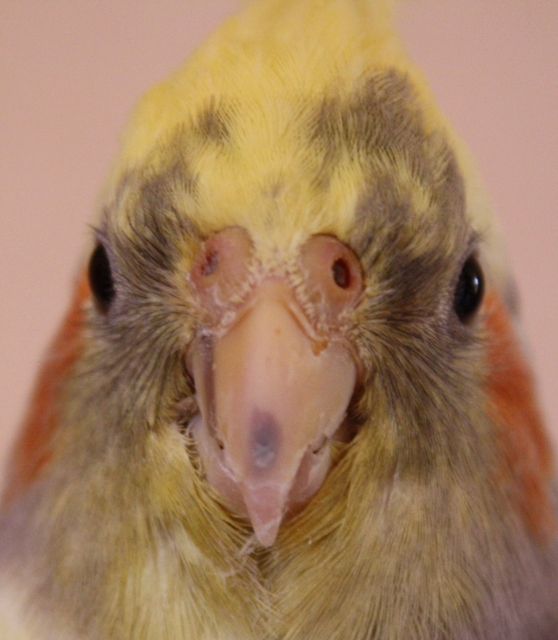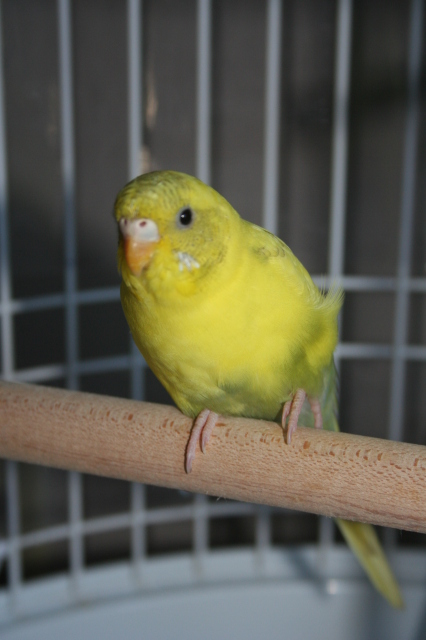QuestionQUESTION: Hi, I asked you a question a couple of days ago about fixing splayed legs in my baby parakeet. I used the sponge method of fixing the legs, and so far, it seems to be working. I
did, however, have to start handfeeding the baby. Today was the first full day of handfeeding and I have a few questions.
1. The baby is 11 days old, how often do I need to feed it?
2. Do I need to get up during the night to feed? Last night I fed at midnight, 2:00 am, 3:30 am, 6:00 am, 7:30 am, and 9:30 am, after that, I've tried to feed every 2 hours or so.
3. I have read online that it is very important for the crop to completely empty once every 24 hours to prevent crop infections. How do I ensure that the crop is completely emptying?
4. Are there any other problems I need to look out for?
5. How much should it be eating? I have a 10 cc oral syringe that I am using. It eats almost a complete syringe full each time.
6. Do I need to be careful about excess air in the syringe being "swallowed" by the baby?
I am making sure that the formula isn't too hot or too cold. I don't have a thermometer, but I test the temperature the way I always tested my kids bottles when they were babies. If it feels warm to my wrist/finger, then I feed it.
Thank you for any help you can give to me.
Sincerely,
Cheryl Flora
ANSWER: Hello again Cheryl.
I do remember your question about the baby with Splay Leg, and if I remember correctly, I sent you a link for the site that one of our other Experts has set up, if I didn't, I do apologize and I will send it with this post.
It is very important that you use a thermometer for the baby's formula. If the formula is too hot, it will burn the babys crop, and if it is too cool, it will not be able to empty from the babys crop.
I am also sending a copy of the section from the site that I mentioned. This is on hand feeding. The section will answer all of your questions and more.
http://www.angelfire.com/falcon/birdinfo/parrots_page1.html
HANDFEEDING BABY BIRDS: Handfeeding baby parrots is the best method of imprinting them to humans in order to end up with a tame bird. The process results in a trusting relationship, which is critical for a parrot/human bond. The baby learns that you are it's food source, it's teacher, protector, it's mom and dad, and it depends on you for it's survival. The baby(ies) will learn to LOVE your fingers and hands because that's where their food comes from during the feeding process! Depending on species, health, and number of babies in a clutch, I generally pull babies from their parents for handfeeding at 10-14 days. Parakeets/budgies can be pulled at 7-10 days (these birds are easy to handfeed), cockatiels at 10 days, and I prefer to pull lovebirds for handfeeding no later than 10 days. Medium to larger species of parrots mature a little slower, but these can be pulled for handfeeding at about 14 days. Sometimes it's necessary to pull a baby for handfeeding right after hatching or soon after hatchinig for reasons, such as parents not feeding, baby not taking parent feeding well, parents not feeding enough, etc. Handfeeding newly-hatched chicks can be very difficult, therefore, have some knowledge in this area if you are expecting hatchlings. When a pair of birds have a full clutch of babies (usually 4-6), I begin pulling the older babies as soon as possible so that the younger babies receive enough food. However, I never pull just one baby or leave just one baby in the nestbox...the other sibling provides warmth, company, and traction for legs. Do not pull babies for handfeeding and handfeed them for a day/couple of days and expect the parents to welcome them back in the nestbox for feeding. In other words, handfeeding baby birds is a commitment you make. It depends on the individual birds, but many parent birds will neglect, injure, and/or kill babies that have been replaced after having been absent for a period of time. It isn't that they are mean, or cannibles, etc., it's because they may not recognize them as their babies any more. So, bottom line, if you make a decision to handfeed, you have to make yourself available at the required times and for the required number of feedings every day until the baby(ies) are weaned.
If you have a baby parrot(s) to handfeed, you'll need baby bird handfeeding formula (there's regular and a type just for macaws...buy the correct blend for your baby(ies)), handfeeding syringes to fit size/type of bird (or small spoons, etc.), a thermometer to test the temperature of the formula, a brooder or other container to house the babies (once they are pulled from the parents for handfeeding), a heating pad (if brooder isn't heated), a thermometer to track temperature within container (unless a heated brooder is used), lots of paper towels, and some type of substrate for under baby(ies) to keep them dry until they are ready for a cage (pine shavings, processed paper pellets, paper towels, etc.). I recommend the use of Rubbermaid drawer liners, cut to the appropriate size, for use under the baby(ies) for traction so they do not become splay legged from standing/trying to stand on a slippery surface. This rubber material can be washed and disinfected in-between cleanings, is inexpensive, and lasts a long time. If you don't use a brooder, you can make a container out of many items. I've had much success with glass fish aquariums (1, 5, 10 gallon...depending on age and number of inhabitants), but just about anything that is enclosed to keep out drafts/keep warmth inside, won't overheat/melt (from heating pad underneath), that allows air circulation, easy to clean and disinfect, etc. Baby birds must be kept at about 95-98 degrees F when they do not have feathers. Temperature can be lowered as pin feathers and normal feathering develop. However, the heat is also required for metabolizing food in the crop. Therefore, even with feathering up to a certain age, some amount of heat will be required. I normally remove heat completely when baby(ies) are feathered and able to eat/properly metabolize cold/room-temperature food. The amount of extra heat you need to provide also depends on temperature within the immediate area of the birds, i.e., if the room isn't air conditioned and it's a hot summer day, the ambient temperature may be sufficient during the daytime for a partially-feathered baby. In feeding baby bird formula, follow the directions on the back of the packaging for mixing. Baby bird formula MUST be fed to the baby(ies) at a temperature of 102 - 105 degrees F. This means when the formula enters the baby's mouth, it must be 102 - 105 degrees F. This is why you need a thermometer to test the temp of the formula. If not the correct temperature, the baby's body won't be able to process the formula. This is called crop stasis and is harmful to the bird. The formula will harden in the crop, will not digest, and becomes a breeding ground for bacteria and other undesirables. Subsequent feedings make this condition worse and the baby can become quite ill. This temperature is the temperature of the food regurgitated by parent birds when feeding their babies (it's the same temperature as the parent's body). There's a right and wrong way to feed baby parrots. Feeding the wrong way can quickly kill a baby. Once you have baby bird formula in the syringe at the correct temperature, with the baby facing you, insert the tip of the handfeeding syringe into the bird's beak feeding from right side of beak into/toward left side of mouth. However, before feeding the baby, you must obtain a feeding response from the baby. This feeding response prepares the baby physically to accept the formula. To obtain a feeding response, gently take your index finger and thumb of one hand and rub/massage the baby's beak at the base where the beak meets the face. A feeding response is obtained when the baby "bobs" it's beak up and down, as though it were eating from your fingers. This response allows the trachea to close so when delivering the formula into the baby's beak, the formula goes down the esophagous and not the trachea. If liquid goes down the trachea, it enters the lungs/air sacs and can asperate a baby parrot. Asperation can result in pneumonia and/or death within minutes. Depending on the age/size of the baby, you should feed one drop at a time or several drops at a time until the crop is nearly filled. For example, a newly hatched baby should only be fed one drop at a time, while a 3-week old baby might demand a mouth full at a time. The amount placed in the mouth at a time can be increased with age. Feed according to the ability of the baby to handle the food, even if this means you'll have to feed more often. Fill the crop just shy of full, as bird formula tends to expand in the crop, particularly if not mixed completely in the beginning. If you see food backing up into the baby's neck, you've feed too much. Try to avoid overstretching the crop by feeding too much formula at a feeding. You can avoid overstretching by watching to ensure you don't see food backing up into the neck. An important observation here...when you place food into the baby's mouth, it takes a few seconds for that food to make it's way down into the crop. Therefore, let the baby swallow a few times to work the food down before you inspect the crop to see how full it is. I need to mention temperature of the formula again here...if the formula is too hot, you can burn the baby's crop from the inside out. This will show up as a hole on the outside of the crop (with formula oozing out possibly). The baby will most likely pass away if this occurs, but if it happens and you catch it in time, an avian veterinarian can sometimes help if the burn isn't too severe. Once baby's start receiving their food, they get sleepy just like we do when we have a full stomach of warm food, so you might have to awaken the baby a couple of times between drops of food in order to complete the feeding. Be sure to check for the feeding response again. However, if the baby is too sleepy, the feeding response might not come, so stop feeding and feed again later. I always like to provide a bit of water at the end of each feeding to clear remaining formula out of the mouth and because the baby needs water. I also mix human baby food into the parrot handfeeding formula for extra vitamins/minerals. A newly hatched baby will need to be feed every 2 hours until it is approximately 1 week old (depending on the species), even during the night. Babies 7-10 days old to beginning of weaning age (usually about 4 weeks old) need to be fed every 4 hours, except during the night. This means about 7:00AM, 11-12, 4-5PM, and again about 9-10PM. Use a different handfeeding syringe for each baby being fed and clean and disinfect the syringes and other utensils in between feedings. This prevents cross contamination if one of the babies is ill. I wash with hot soapy water and soak in Vanodine (or bleach water) to disinfect.
Please let me know how it's going.
God Bless.
Dianna
---------- FOLLOW-UP ----------
QUESTION: Thank you so much! Yes, you did give me that web address before, I forgot to bookmark it in my favorites. I did this time!
I started feeding every 4 hours today. Sometimes though, the baby will start crying to be fed after only 2-3 hours. Should I go ahead and feed, or wait until the proper time?
I have named the baby "Pip". Pip has a brother or sister who is still with it's mom. The sibling is much bigger than Pip, and is starting to get feathers on it's wings. (We have named the sibling "Merry" (like Merry and Pipen from the "Lord of the Rings") I believe Merry and Pip hatched on the same day, but is Pip smaller because Pip was weaker and had the splayed leg? Pip only has fuzz and is just starting to get pin feathers.
The only thermometer I have is the one I use for my kids. Will that work to measure the temp. of the formula?
Thanks!
Cheryl
AnswerHello again Cheryl.
Yes, you can use the thermometer that you use for your kids, just be sure to clean and disinfect it before each use for feeding.
You might have to increase the feeding times or the amount that is fed. Just be sure that the babies' crops are completely empty before you feed them the next time.
Please keep me updated.
God Bless.
Dianna

 Identification of a bird
Question
Bird name
Please can you advise what th
Identification of a bird
Question
Bird name
Please can you advise what th
 Color of my indian ringneck
Question
Boots
I have an eleven week old male ringneck
Color of my indian ringneck
Question
Boots
I have an eleven week old male ringneck
 Bruise-like discoloration of beak (Cockatiel)
QuestionSasha
QUESTION: Our Cockatiel has develo
Bruise-like discoloration of beak (Cockatiel)
QuestionSasha
QUESTION: Our Cockatiel has develo
 Budgie has broken foot?
Question
Maggies foot
Hi there! I got a baby budgie a f
Budgie has broken foot?
Question
Maggies foot
Hi there! I got a baby budgie a f
 Eggs! :(
QuestionBroken Egg
QUESTION: I understand lovebi
Eggs! :(
QuestionBroken Egg
QUESTION: I understand lovebi